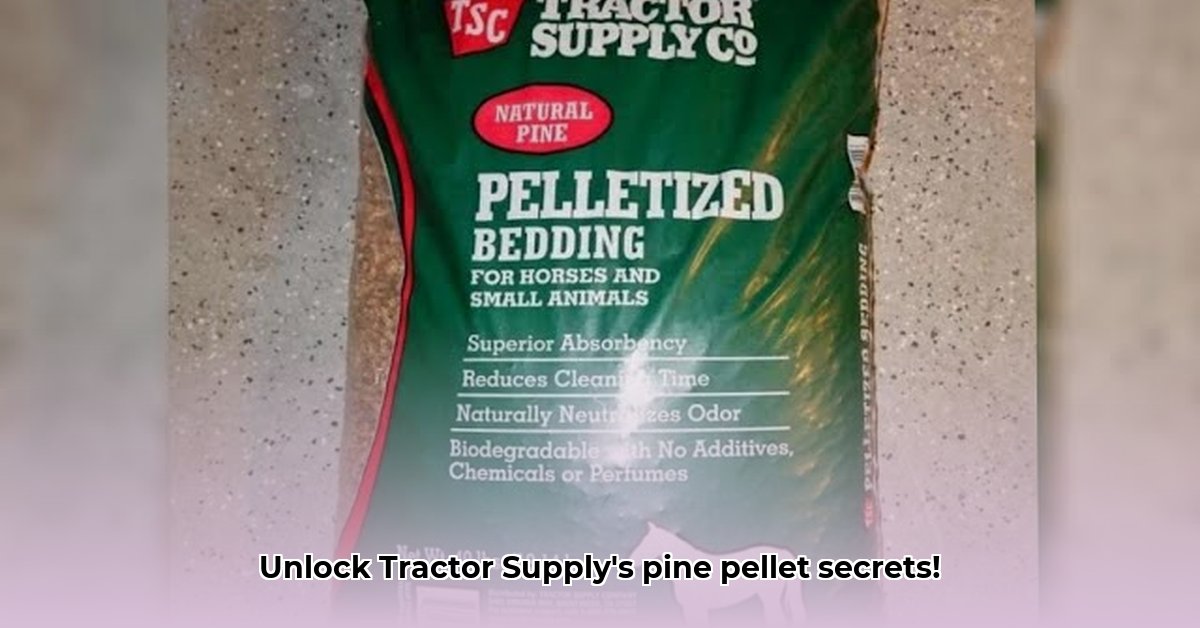
Choosing the right bedding for your animals is crucial for their health and your farm's efficiency. This guide explores Tractor Supply Co. pine pellets, weighing their advantages and disadvantages to help you make informed decisions for a sustainable and cost-effective operation. For more information on wood pellet fuel, visit this helpful resource.
Understanding Tractor Supply Co Pine Pellets: A Deep Dive
Wood pellets, particularly those from Tractor Supply Co., are gaining popularity due to several key advantages. Their high absorbency reduces the frequency of cleaning, saving you valuable time and labor. Their uniform size and shape simplify handling and even distribution, unlike less consistent materials like straw. This contributes to improved hygiene, reducing the risk of bacterial or fungal growth and promoting a healthier environment for your animals. This neatness also translates to efficient storage, a significant benefit for smaller farms.
Environmental Considerations: Sustainable Sourcing is Key
The environmental impact of pine pellets hinges on their source and production. Pellets from responsibly managed forests have a significantly smaller carbon footprint than those sourced from unsustainable logging practices. Look for certifications like the Forest Stewardship Council (FSC) label to ensure sustainable sourcing. The transportation distance also plays a crucial role; locally sourced pellets reduce your farm's overall carbon emissions. Remember, the pellet production process itself consumes energy, so complete environmental neutrality isn't achievable, but minimizing the impact is possible through informed choices. What questions should you ask your supplier to ensure sustainable practices?
A Step-by-Step Guide to Choosing the Right Pine Pellets
Selecting the optimal bedding involves a careful assessment of your needs and resources. Follow these steps for a successful and eco-conscious approach:
Assess Your Needs: Consider the number and type of animals you have. Their individual requirements (size, age, health) will influence the amount of bedding needed and its ideal properties. Different animal species have varying sensitivities to different bedding materials.
Trace the Source: Investigate the origin of the Tractor Supply Co. pine pellets. Look for certification logos on packaging, indicating sustainable forestry management. Understanding the supply chain's transparency helps you minimize your environmental impact.
Analyze Total Cost: Don't just focus on the initial purchase price. Factor in potential savings from reduced labor associated with easier cleaning and infrequent changes. Weighing the initial investment against long-term labor savings provides a more comprehensive cost analysis.
Explore Alternatives: Research alternative bedding materials like recycled paper, hemp, or other sustainable options. Comparing their pros and cons allows you to make an informed decision aligned with your specific farm needs and environmental priorities. Experimenting with smaller quantities of different materials allows for practical testing.
Plan for Disposal: Consider the end-of-life management of the used bedding. Composting is often a viable option, turning waste into a valuable soil amendment. If composting isn't feasible, ensure you have a responsible disposal plan to minimize environmental impact.
Weighing the Pros and Cons: A Balanced Perspective
| Pros | Cons |
|---|---|
| Superior absorbency, reducing cleaning frequency | Potential environmental impact if unsustainably sourced |
| Improved animal hygiene and health | Transportation emissions if not locally sourced |
| Easier handling and storage | Energy consumption during pellet manufacturing |
| Reduced odor | May not be suitable for all animal types |
The Future of Sustainable Bedding: Trends and Innovation
The bedding market shows promising advancements. We can anticipate an increasing availability of pellets made from recycled wood and agricultural byproducts. Research into more energy-efficient manufacturing processes is ongoing, further reducing the environmental footprint of pellet production. Increased transparency in supply chains will empower farmers to make more informed, sustainable choices. By choosing consciously today, you contribute to a healthier environment and a more sustainable future for your farm.
Key Takeaways: Sustainable Practices for Wood Pellet Bedding
- Prioritize sustainable sourcing: Opt for pellets certified by organizations like the FSC.
- Optimize storage and handling: Minimize waste through efficient usage and proper storage.
- Embrace responsible disposal: Compost spent bedding whenever possible or develop a responsible disposal plan.
- Regularly monitor and improve: Track your usage and identify areas for optimization.
By following these guidelines, you can maximize the benefits of Tractor Supply Co. pine pellets while minimizing their environmental impact, fostering a healthier environment for your livestock and a sustainable future for your farm.